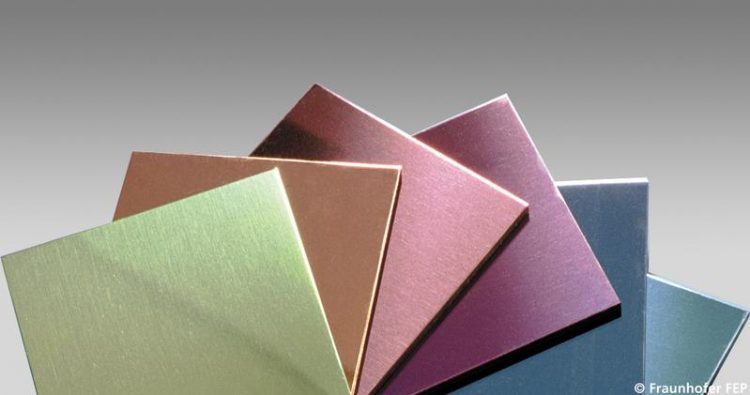Brilliant decorative solid-state thin films for metallic coverings and facades

Plates coated with interference colors Fraunhofer FEP
Metallic surfaces must be able to meet many requirements: they should, for instance, be scratch-resistant, water-repellent, matte or antibacterial. For the most part, surfaces should also be aesthetically appealing. Coatings must therefore take on numerous functionalities at once. The application of such decorative multifunctional layers onto smaller surfaces is currently already unproblematic, as thin solid-state layers can be applied in a vacuum.
When one now considers entire house facades, coverings, or wall panels made out of sheet metal, then it is no longer a simple matter to evenly and decoratively coat such large areas.
The Fraunhofer FEP has several solutions in place. For years, the scientists have been working on technologies for surface layer coating. For example, they have roll-to-roll equipment where they are able to vacuum coat metal strips with differing materials and colors. On a gold-colored surface, for example, titanium nitride layers are used, which not only look decorative, but also protect the surface from deterioration and corrosion.
In contrast to such colors, which are induced through light absorption within the material of nitride or carbide layers, so-called interference colors are based upon thin transparent oxide layers (for example, titanium oxide).
They produce especially brilliant colors. The interference effect is known from oil in a puddle, where the oil will shimmer in the most varied colors under the light of the sun. Depending on the desired colors, scientists are able to precisely apply the appropriate oxide layer in a vacuum.
They can thus depict a great variety of colors in varying nuances. The selected oxide layers are scratch resistant and, following an ultraviolet light irradiation, take on a photo catalysis state, which allows the surface to be cleaned easier.
Professor Metzner, division director of „Coating of sheets and metal strips” at the Fraunhofer FEP, explains: “Because of our many years of experience in the development of processes, we are able to offer our clients and partners a broad spectrum of decorative layers and can optimize these for the specific intended usage.”
Not only flexible metal strips can be coated at Fraunhofer FEP. Of course, rigid sheets can also be coated. The scientists are supporting industrial partners across the entire scale of product development. Starting from feasibility studies to sampling of surfaces to process development under laboratory conditions, Fraunhofer FEP is able to adopt an initial pilot production in their large plants together with industrial customers. The surfaces coated at Fraunhofer FEP not only look good – they can be provided with additional functions as per the wish of the customer, such as coats against scratches or fingerprints.
Press contact:
Mrs. Annett Arnold
Fraunhofer Institute for Organic Electronics, Electron Beam and Plasma Technology FEP
Phone +49 351 2586 452 | annett.arnold@fep.fraunhofer.de
Winterbergstraße 28 | 01277 Dresden | Germany | www.fep.fraunhofer.de
Media Contact
All latest news from the category: Architecture and Construction
Newest articles

A ‘language’ for ML models to predict nanopore properties
A large number of 2D materials like graphene can have nanopores – small holes formed by missing atoms through which foreign substances can pass. The properties of these nanopores dictate many…

Clinically validated, wearable ultrasound patch
… for continuous blood pressure monitoring. A team of researchers at the University of California San Diego has developed a new and improved wearable ultrasound patch for continuous and noninvasive…

A new puzzle piece for string theory research
Dr. Ksenia Fedosova from the Cluster of Excellence Mathematics Münster, along with an international research team, has proven a conjecture in string theory that physicists had proposed regarding certain equations….



